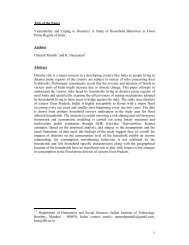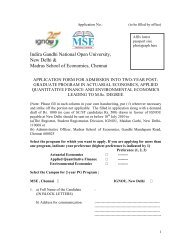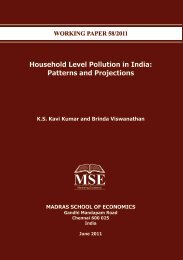A Macro-Fiscal Modeling Framework for Forecasting and Policy ...
A Macro-Fiscal Modeling Framework for Forecasting and Policy ...
A Macro-Fiscal Modeling Framework for Forecasting and Policy ...
You also want an ePaper? Increase the reach of your titles
YUMPU automatically turns print PDFs into web optimized ePapers that Google loves.
Chapter 2<br />
STATIONARITY AND STRUCTURAL BREAKS: SELECTED MACRO<br />
AGGREGATES<br />
In this Chapter, we discuss issues related to stationarity of macro economic time series.<br />
In the literature, the importance of determining whether a time series is difference<br />
stationary or trend-stationary has been much emphasized. If a series is difference<br />
stationary, the appropriated modeling methodology would be cointegration with error<br />
correction. If a series is trend-stationary, the conventional methodology of specification<br />
<strong>and</strong> estimation would be relevant. In recent literature, macro economic series are often<br />
found to be trend-stationary with one or more structural breaks. Identifying the timing of<br />
such structural breaks there<strong>for</strong>e becomes quite important.<br />
With the publication of the seminal paper by Nelson <strong>and</strong> Plosser (1982) on<br />
“Trends <strong>and</strong> R<strong>and</strong>om Walks in <strong>Macro</strong>economic Time Series”, an extensive debate was set<br />
in motion whether most macroeconomic series were trend-stationary or differencestationary.<br />
The latter category of series is characterized by a unit root. Nelson <strong>and</strong><br />
Plosser themselves had concluded that most of the important US macroeconomic series<br />
including GNP, prices, employment <strong>and</strong> interest rate were I(1) variables; that is, they<br />
contained a unit root. The presence of unit roots rendered many existing estimations of<br />
economic relationships spurious. It also led to one body of literature focused on<br />
decomposing macro series between permanent <strong>and</strong> cyclical components. The permanent<br />
component indicates the persistence of macroeconomic shocks. Nelson <strong>and</strong> Plosser's<br />
study was followed by a series of empirical analyses which basically confirmed their<br />
findings. Stulz <strong>and</strong> Wasserfallen (1985) <strong>and</strong> Wasserfallen (1986), Dickey-Fuller (1979)<br />
among others applied a similar statistical methodology to other economic series.<br />
Some other important contributions relating to this topic are Campbell (1986),<br />
Mankiw (1987), Cochrane (1988), Diebold <strong>and</strong> Rudenbusch (1989) <strong>for</strong> univariate contexts<br />
<strong>and</strong> Shapiro <strong>and</strong> Watson (1988) <strong>and</strong> Blanchard <strong>and</strong> Quah (1989) <strong>for</strong> multivariate<br />
contexts. The attempts to decompose GNP <strong>and</strong> money supply series between permanent<br />
<strong>and</strong> cyclical components also led to a considerable theorizing of particularly, business<br />
cycles of real business cycles theory (see King <strong>and</strong> Plosser, 1984).<br />
Another direction in which the literature evolved related to cointegration <strong>and</strong><br />
error correction models that were initiated with the seminal work of Engle <strong>and</strong> Granger<br />
25



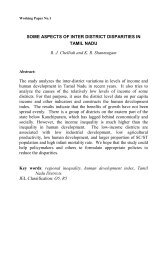

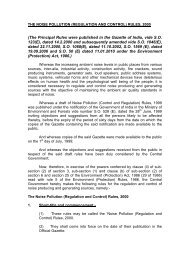
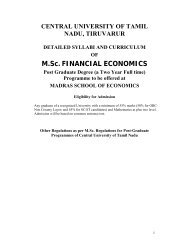
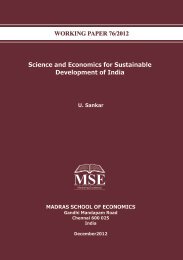
![Curriculum Vitae [pdf] - Madras School of Economics](https://img.yumpu.com/49878970/1/190x245/curriculum-vitae-pdf-madras-school-of-economics.jpg?quality=85)
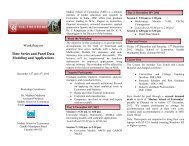
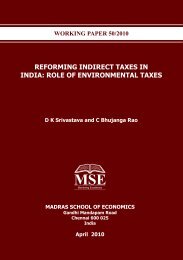
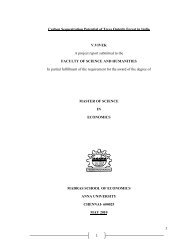
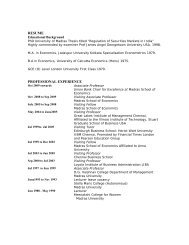
![Curriculum Vitae [pdf] - Madras School of Economics](https://img.yumpu.com/48715201/1/184x260/curriculum-vitae-pdf-madras-school-of-economics.jpg?quality=85)
